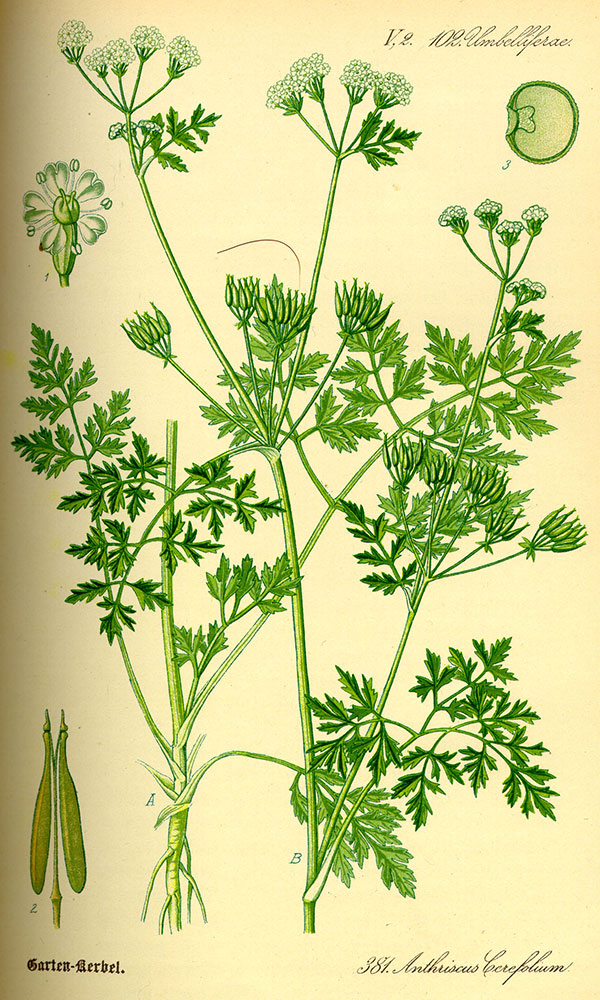Chervil

Chervil (Anthriscus cerefolium)
Illustration - Prof. Dr. Otto Wilhelm Thomé Flora von Deutschland, Österreich und der Schweiz (1888) (PD)

Chervil - Botany And History
Chervil is a small, shrub-like annual herb possessed of a hardy nature but a delicate temperament which is usually characterised by its broad, somewhat dentate, bordering on unevenly serrated (tripinnate) flat dark-green to jade-green leaves of a highly aromatic nature. It is also noted for its tiny white to offwhite inflorescence which blooms during the early summertime. Chervil also boasts tiny fruits which form the fertilised flowers and measure a trifle at some two centimetres, characterised by its somewhat ovoid shape and its slender, ridged beak. Chervil is a relatively small herb or shrub, measuring no more than twenty inches if left to its own devices, although it is usually 'trimmed' through constant picking of the leaves. Chervil prefers moist, cool environments and nutrient-rich soil.
In spite of being somewhat 'picky' with regards to its environs, chervil is capable of growing in restricted environments for long periods of time (as evidenced by its propensity to be grown in tiny pots, typically in kitchen settings), although if left to its own devices in the wild it has the tendency to thrive and spread widely from its main 'body', especially if the plant is situated in highly ideal conditions. It is commonly employed as a culinary spice in a large part of the Western world and plays and integral role in Mediterranean, European (predominantly French), and (later on) American cuisine, and is notable for its slightly aniseed-like aroma.
Chervil was originally harvested wild, although it was later cultivated and propagated chiefly by the Romans, who employed the herb as a near-indispensible spice. Chervil may have had its origins in the Caucasus, where it is believed to have been a native. It was known to the Ancient Greeks, the Early Romans, and even the Ancient Chinese, although its usage was more predominant in the Western areas of the globe more so than the Eastern, with some exceptions as evidenced by its presence and mention in Traditional Chinese herbals. The spread of chervil (and the origin of much of its use) throughout the European continent is due to the zealous cultivation and propagation conducted by the Romans wherever they set up garrisons, camps or settlements. As the Roman Empire grew, so too did the spread of chervil throughout Europe, until the plant eventually became naturalised, and, by the time of the Empire's decline, became part of the local landscape and inextricably bound to the lore and herb-craft of the peoples. [1]
Chervil - Herbal Uses
Chervil is most commonly employed as a culinary herb, typically in lieu of herbs such as dill, thyme, or parsley. Because of its slightly aniseed or liquorice-like aroma and flavour profile, it can and has even been employed as a substitute for such herbs, although due to the delicacy of its flavour, it only works superficially as a substitute. It is most commonly employed in French and Mediterranean cuisine as part of the herb mixture referred to as fines herbes - a combination of several herbs which are specifically chosen for their mildness of flavour and the 'slow release' of aromas and flavours which are excellent for slow cooking methods, unlike the hastier and more potent flavour release associated with the herbs that comprise bouquet garni. Because of this employment, chervil is a prime choice for making stocks, although its delicate flavour generally relegates it to mild dishes such as seafood and some types of poultry. For heartier or heavier foodstuffs, chervil may be incorporated as a means to balance out the flavour, or to otherwise add a touch of flavour meant to simply enliven, instead of wholly compliment and embolden the dish. Chervil may also be employed for fresh green salads, usually when plucked fresh and employed in its whole form, although it can be chopped or diced finely and sprinkled on salads; it works especially well when combined with tangy or otherwise pungent cheeses, as its unique flavour adds a little twist to the food, increasing its savour. [2]
Prior to its usage as a purely culinary herb, chervil was once predominantly employed as a medicine by many cultures, although its most common users veered more towards the European and Indo-European sphere than the Asiatic. The oldest extant remedies that incorporate chervil were digestive draughts made by infusing dried chervil leaves in apple-cider vinegar and drinking a dilution of the liquid prior to meals and after meals in the belief that it promoted digestion and helped to prevent diarrhea, bloating, and dyspepsia. This self-same substance was even believed by folkloric healers to be a remedy for hiccups and mild nasal congestions. [3] Earlier usage usually attributed to the Ancient Greeks and Early Romans also suggests that the herb was predominantly used (often mixed with wine or some other alcoholic beverage, either as a maceration, a heated infusion, or simply as an additive) as a drink which was believed to 'dispel melancholy'. [4] This practice of partaking of alcoholic infusions of the herb persisted until well into the Renaissance, where it was still considered a soothing, uplifting, and comforting draught. By the Elizabethan Era, chervil took on more medicinal attributions, and was considered as a restorative, a rejuvenating herb, a mild analgesic, a decongestant, and even a blood purifier. Latter remedies suggested that moderately strong to very strong decoctions of chervil leaves were an excellent draught to be taken after the wintertime, where it not only helped to 'shrug off' the illeffects of cold, but also added to the liveliness and overall improvement of the bodily functions after a long interval of sluggishness. Most oral medicinal applications for chervil typically employ it as an anti- histaminic, mild analgesic, and anti-hypertensive, although its efficiency as the latter is somewhat debatable. [5] Extremely mild decoctions or infusions of chervil have even been employed by a number of different cultures (predominantly in the West) as an excellent eye wash which is said to help treat sore eyes, conjunctivitis, and a number of other ocular complaints.
Applied topically, it helped to not only disinfect wounds and hasten healing, but was also believed to preserve the youthfulness and suppleness of skin, and was in fact a commonplace beauty remedy during from Middle Ages onwards. [6] From a scientific point of view, chervil does contain potent antibacterial properties found in the essential oils of the leaf (anethole) which is also found in liquorice root and aniseed (hence it's slight resemblance in terms of flavour and aroma to these respective plants). The topical application of chervil may even extend so far as to its employment as a rinse, believed by most folkloric healers as a good remedy for arthritis, rheumatism, and gout. [7] The leaves may be pounded and made into a poultice, either by itself or mixed with a little oil. When heated and applied unto the affected area, it helps to provide relief from rheumatism, arthritis, and general aches and pains. Alternately, one may opt to allow dried chervil leaves to macerate in one's choice of a base oil, with the subsequent substance then topically employed as a salve or ointment for analgesic and anti-inflammatory benefits. One may alternatively opt to purchase the essential oil of chervil (extracted through steam distillation) and combine it with one's choice of a base oil. This ointment can be used as a local antiseptic, a mild anaesthetic, and as topical analgesic when applied liberally to areas which are frequented by pain. When combined with warming and analgesic herbs and spices, the benefits are largely magnified and improved.
The essential oil of chervil, when employed on its own as a medium for aromatherapy may even help to reduce insomnia, restlessness, anxiety, and depression. It may alleviate stress and improve one's overall mood, as it has traditionally been ascribed anti-depressant properties. Mixed with a base-oil and employed as a soothing massage oil, or otherwise dispersed into a room via a diffuser or through the use of oil lamps. Alternatively, one may opt to burn dried leaves of chervil as an incense to facilitate the same beneficial effect. Because chervil possesses natural antimicrobial and pesticidal properties imbued within its inherent active constituents, it has even been employed by organic farmers as a means to rid their plots of slugs and other unwanted pests, although such applications tend to be rare.

Chervil - Esoteric Uses
In spite of its being an ancient herb with a long standing history of ritualistic and medicinal usage, very little esoteric associations with regards to chervil's use survives to this day. It is generally believed by both traditional and 'neo-classical' schools of magick that chervil is an herb which allows an individual to connect to the Netherworlds. Ancient associations typically veer towards its being a protective herb, and it may have been used in the creation of talismans or amulets, if not as a talisman or amulet in its own right, generally encased in some type of medicine pouch. Chervil soon became associated with spiritual activities, with modern associations generally veering towards its capacity as a summoner's herb, generally employed for traffic with other-wordly entities. When burnt as a in incense, it is said to comfort lost spirits, pacify enraged ghosts, and allow oneself to open up and commune with the Netherworld in a far more efficient manner. [8] Chervil can be considered integral to any psychic, necromancer, or shaman's repertoire of herbs, as these three distinct magickal fields tend to commune more with the Spirit World than do others. Aside from its usage for spiritual communication and for protection, there seems to be no other esoteric purpose for chervil, either traditionally, or in a more modern application.
While chervil is considered perfectly safe when consumed in moderate dosages both medicinally and as a culinary herb or condiment, pregnant women are advised to avoid the consumption of products which contain significant amounts of chervil, whether it be food or natural medicinal preparations, as chervil may inadvertently affect the proper development of the foetus, which may result in mutations. Individuals who are under specialised medications, whether natural or synthetic, should also only consume minute amounts of the herb, for while there has yet to be any reports on adverse reactions with any known synthetic or organic medication, the lack of available data also points out to its relative unpredictability.
Chervil - Other Names, Past and Present
Chinese: xi ye qin
Japanese: chabiru (onomatopoeic transliteration of the English 'chervil')
Korean: chabil (onomatopoeic transliteration of the English 'chervil')
Hindi: cevila (perhaps a transliterated corruption of the English 'chervil')
Greek: anthriksos
French: crefeuil / crefeuil commun / crefeuil des jardins / herbe aiguillee / persil d'Ane / persil
d'Anis
Italian: perifollo / perifolio / cerfoglio
Spanish: perifollo
German: kerbel
Dutch: kervel
Swedish: korvel
Latin (scientific nomenclature): Anthriscus cerefolium
References:
[1 - 2] https://en.wikipedia.org/wiki/Chervil
[3] https://www.webmd.com/vitamins-supplements/ingredientmono-250-CHERVIL.aspx
[4] https://www.anniesremedy.com/herb_detail95.php
[5] https://www.naturalstandard.com/news/news201112027.asp
[6] https://alternativemedicineblogs.blogspot.com/2010/03/healing-properties-of-chervil.html
Main article researched and created by Alexander Leonhardt.
© herbshealthhappiness.com


1. Famous Chef Sheds 60lbs Researching New Paleo Recipes: Get The Cookbook FREE Here
2. #1 muscle that eliminates joint and back pain, anxiety and looking fat
3. Drink THIS first thing in the morning (3 major benefits)
4. [PROOF] Reverse Diabetes with a "Pancreas Jumpstart"
5. Why Some People LOOK Fat that Aren't
6. Amazing Secret Techniques To Protect Your Home From Thieves, Looters And Thugs
7. The #1 WORST food that CAUSES Faster Aging (beware -- Are you eating this?)
If you enjoyed this page:





























